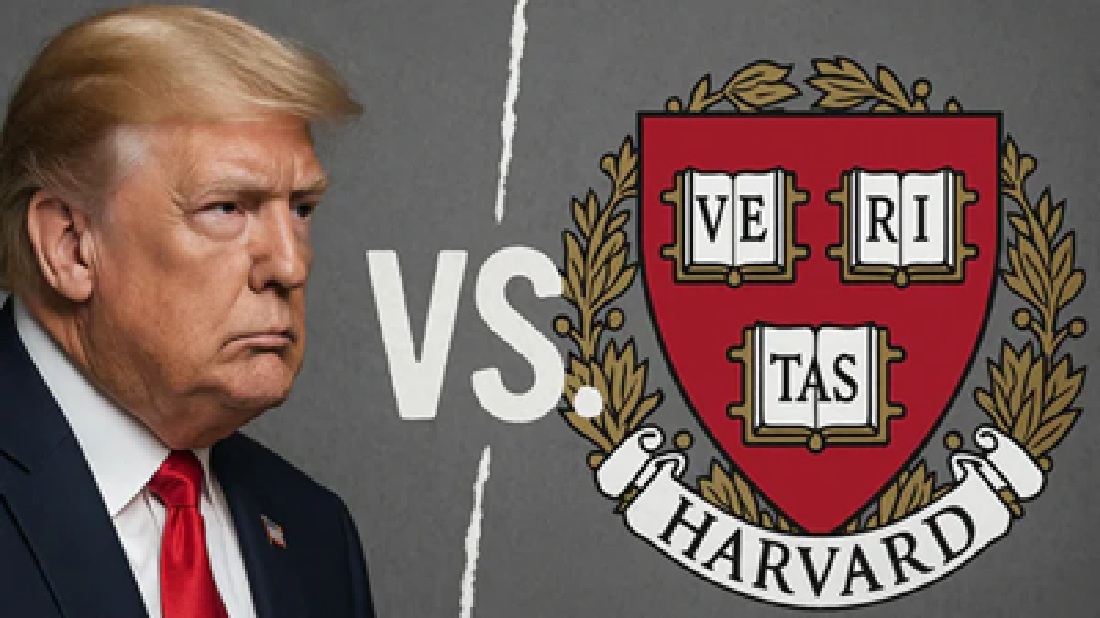A confrontation unfolds between President Donald Trump and Harvard University, raising questions about academic freedom, federal authority, and the future of elite education.
When you think of a top world renowned college, one synonymous with prestige, excellence, and intellectual legacy, one college that comes to your mind is Harvard. It has always topped the list. It’s more than just a university. It’s an institution woven into the very fabric of American history and power. But today, this symbol finds itself under political pressure from a president, sparking one of the most intense standoffs in the history of American higher education.
Presidential Pedigree: Harvard’s White House Legacy
Eight US presidents have graduated from Harvard University. John Adams, John Quincy Adams, Rutherford B. Hayes, John F. Kennedy, Franklin D. Roosevelt, Theodore Roosevelt, George W. Bush, and the latest president to graduate is Barack Obama. Not just that, dozens of billionaires, Nobel laureates, and world leaders have walked its hallowed halls.
Harvard’s Role in the American Dream
To many Americans, Harvard represents the pinnacle of opportunity. But in recent times, Harvard has found itself at the center of a cultural and political storm, facing off against none other than the US President Donald Trump. So on one side, we have the United States of America’s most powerful person who is determined to break the political, cultural, and academic diversity of elite education institutions and on the other there’s Harvard University, the country’s oldest, richest, and most recognizable academic brand.
So what actually happened? Why are we talking about Trump and Harvard?
The Federal Letter That Sparked the Fire
What started as a bureaucratic inquiry into campus anti-semitism has now turned into a high stakes constitutional standoff – one that could redraw the lines between federal authority and academic freedom in the US. It all started with a letter to the president of Harvard in which the Trump administration laid out the following demands and all these demands were pertaining to hiring teaching practices as well. So here are the following demands.
1. Reducing decision-making power from students, faculty, and internal administration.
2. Banning all preference based on race, religion, gender, or nationality.
3. Revising admission policies to exclude individuals deemed ideologically hostile.
4. Authorizing a federal body to audit ideological diversity on campus.
5. Investigating anti-Semitism under federal oversight.
6. Terminating all Diversity, Equity, and Inclusion (DEI) initiatives.
Harvard’s Defiant Response
Within 72 hours, Harvard University pushed back. Its president asserted that the demands represented an overreach of federal authority and stated unequivocally that the institution would not compromise its constitutional autonomy. The decision is one of the most overt defines by universities since US President Donald Trump began pressuring high education to confirm to his political priorities.
Trump Strikes Back: Financial and Legal Retaliation
In response, the Trump administration placed a $2.2 billion funding freeze. Not just that, Trump further upped the ante by threatening the university’s tax exempt status and demanding an apology for what he called terrorist inspired supporting sickness on campus. The demands at the offset seem like they encourage more accountability and merit, but there’s more than what meets the eye.
The letter by Trump essentially targets the massive pro Palestine demonstrations across several US colleges. Harvard being one of them. At the heart of these demonstrations were two demands:
1. End Israel’s military actions in Gaza
2. Urge divestment from Israeli-linked institutions
Police Crackdown and Student Repercussions
The student led demonstrations witnessed intense police crackdown in 2024. Many students arrested, more faced the danger of deportation for their demonstrations against Israel and for Palestine. And now the university itself is facing action. The question now is, can Harvard, the richest US college, withstand Trump? The wealthiest US college has longed cash and built its budget to withstand shocks.
Financial Might: How Harvard Is Shielding Itself
According to Harvard’s financial statement, the university is armed with pristine credit ratings and a $53 billion endowment, which is the most of any school in the US. And this affluence makes it well situated to weather any kind of blows. That’s not all. In fiscal year 2024, Harvard raked $6.5 billion of annual revenue and enjoyed a $45 million surplus. Apart from this, Harvard’s funding comes from diverse revenue streams like tuition donation, research grants and also executive education.
Resilience Through Alumni Power
To add to the list, Harvard consistently raises billions through alumini and philanthropic networks. And finally, Harvard’s global prestige ensures continued demand, partnerships, and private investment.
The bottom line is this. Harvard is more than capable of withstanding Trump at this point of time. Now let’s tell you about the strong Harvard alumini network. Harvard alumini account for 5% of the world’s ultra high net worth population.
Harvard’s alumni base is another bulwark. As per Altrata, it boasts 17,660 ultra-high-net-worth alumni—individuals with assets exceeding $30 million.
The university’s alumini network is arguably the most prestigious and far reaching of any college with over 370,000 living alumini across virtually every field. And the Harvard Alumini Association has over 200 clubs worldwide to facilitate all these connections.
Let’s now tell you about the top countries of Harvard Alumini. That’s United Kingdom, Australia, Hong Kong, Canada, India, China, and Japan. Harvard is not standing alone. As per reports, 39 institutions across the United States of America have the financial strength primarily in the form of large endowments and diversified revenue streams to resist federal pressure.
These schools include prestigious research colleges like Yale University, the University of NRAEM, Vanderbilt University and Washington University in St. Louis. Wealthy liberal arts colleges also make it to the list such as Williams College and Davidson College in North Carolina. So the bottom line is this. Harvard has the wherewithal to stand against Trump.
Why This Trump and Harvard Fight Matters?
This isn’t just about one university. The battle between Trump and Harvard could redefine:
Federal power over academia – Will other elite schools like Yale face similar demands?
Campus speech – Do protests against Israel warrant federal intervention?
The “meritocracy” myth – Are Trump’s attacks on Harvard really about fairness, or political control?
Conclusion
As Trump escalates his Harvard offensive, the university’s vast resources suggest it won’t fold. But with 39 other wealthy colleges potentially in the crosshairs, this Trump and Harvard showdown may determine whether education serves democracy—or a president’s agenda.

